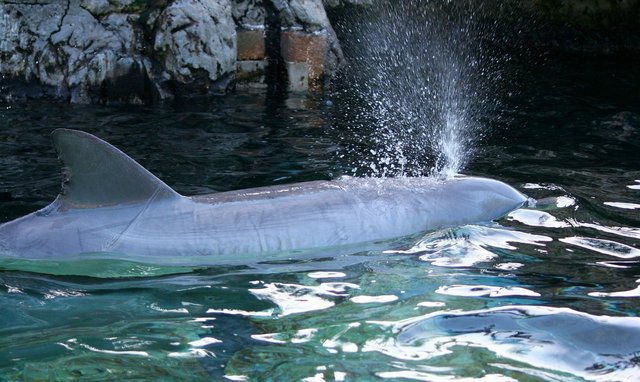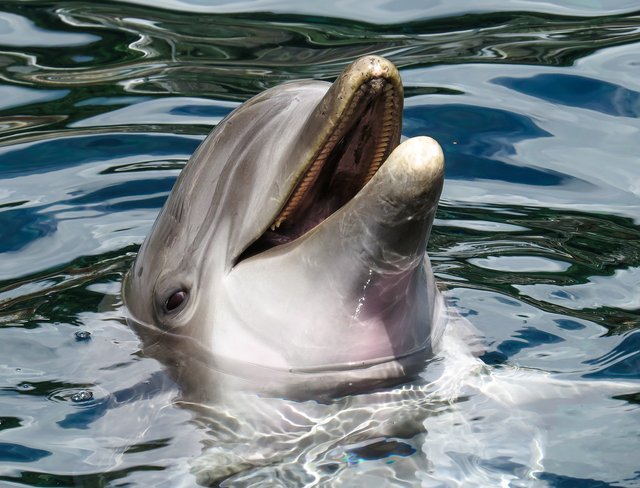Do dolphins drown in water?
I have been meaning to write about the sleeping habits of dolphins and frigatebirds since my last post on the sleeping habits of mallard ducks. The original plan was to talk about the sleeping habits of frigatebirds and dolphins together, but I learned quite a lot of things about both the animals and I decided to devote a post for each of them.
The questions for this post are these: Why can't dolphins breathe under water even though they live in it? Also, how do they not drown when they are asleep? If you live in water and need to come up every few minutes for air, how are you supposed to relax and enter the land of dreams?
How would you feel if you were at a risk of drowning in... air?
The trick is never to fall (completely) asleep
The answer to the problem is unihemispheric sleep, which I talked about in my last post. The idea is that an animal capable of unihemispheric sleep can fall asleep with only half of its brain so that the other half can keep track of things all the time. We can see how that can solve our dolphin's problem. Let's look at this in some detail.
Why can't they breathe underwater anyway?
That's a fair question. If it lives in water, why doesn't it breathe in water like any regular fish? The answer to this question is that a dolphin is not a fish, which brings us to our old friend: evolution.

Although dolphins live in water, they cannot breathe underwater. They have to come to the surface regularly to get some air.
Source: pixabay
The usual story of evolution tells us how aquatic animals slowly moved into land and ultimately evolved into birds and mammals. Well, a little tweak occurred in case of dolphins and whales. About fifty million years ago, mammals that had been living on land went back to the water. They naturally had to acquire skills necessary to survive in the sea, but some things just could not change. The land mammals had, in fact, evolved to not have gills. Gills are organs that can extract dissolved oxygen from circulating water. That is why animals capable of breathing underwater can constantly circulate the water through their gills and get the required oxygen. Humans and other land animals have lungs that can take oxygen from air, but are incapable of breathing dissolved oxygen.
What happened to the gills of our ancient aquatic ancestors? They evolved into ears and started performing a completely different function. The gills of the dolphins had already evolved and disappeared, so they had no way of getting them back!
Living in water, breathing air
Thus, the new swimmers started living in water with a constant need to rise up to the surface for some fresh air every now and then.
They did evolve a clever apparatus called the blowhole, which is similar to a nostril that we use for breathing. The blowhole is situated at the top of a dolphin's (or a whale's) head, and it is actually the animals nostril that kept moving up towards the top through millions of years of evolution. The location of the blowhole has some obvious advantages: the dolphin can swim to the surface and breathe through it without having to stick its nose up in the air.
I don't think about even my own breathing so much.
That's because you don't have to. Breathing in human beings is special because it can be both voluntary and involuntary. While you can draw a deep breath whenever you feel like it, you don't need to think about it at all when you are engrossed with your work, or when you are sound asleep. The mind has subconscious mechanisms to manage the whole thing.
However, if you were a dolphin or a whale, you would not be breathing constantly. Whenever you felt the need for oxygen, you would first move up to the surface of the water and then you would breathe consciously. This need for a conscious trigger for breathing is what makes unihemispheric sleep necessary for these animals. So if half of the brain is always awake, the dolphin can always remember to breathe.
Another important advantage of keeping a half of their brain awake is that they can keep an eye on predators. This important benefit of not falling completely asleep is utilized by ducks as well as humans (in some special cases) as I discussed in my last post. This is possible because when one half of the dolphin's brain is asleep, only one of the eyes is closed while the other eye can still look around.
And the mothers and babies do not seem to sleep at all
A study from 2007 showed that when a dolphin has a baby, the mother and calf seem to get very little sleep of any kind. The mothers monitored in the study seemed to come up to the surface for breathing with both their eyes open more than 90% of the time, whereas the two calves under observation did the same 60% and 90% of the time.
I am sure the sleeplessness will resonate with you if you have ever had a baby.
Interesting fact: when the baby dolphin approached the surface with one of the eyes closed, the open eye was facing the mother. This does seem logical for a baby to do since the mother is the source of both protection and food. However, this is in contrast to the habits of other (adult) animals that practice unihemispheric sleep. Mallard ducks, for instance, have been observed to keep the eye facing the outside world open to keep watch for predators.
So do dolphins ever drown?
Unfortunately, yes. When scientists study the dead bodies of infant dolphins, some of them appear to have never reached the surface after being born underwater. A dolphin under panic may also decide to swim into deeper waters forgetting about the crucial breathing trip to the surface. This apparently happens when a dolphin is caught in a fishing net.
Do they dream?
Dolphin dreams have not been established because Rapid Eye Movement (REM sleep), which is the phase of sleep during which dreaming occurs, is apparently hard to discern in case of these animals. The only recorded instance of REM sleep in an aquatic mammal appears to belong to a pilot whale that dreamed for 6 minutes.

Source: pixabay
Conclusion
I could go on wondering about the stuff of whale dreams, but this has already become a post full of stuff. We saw how dolphins and whales are descendents of land mammals and how this makes it impossible for them to breathe underwater. We also saw how these animals get around that problem by always being careful of their breathing, even during their sleep.
Very interesting questions!
Very interesting post based on research. keep it up @zycr22
Thanks for reading. :)
I enjoyed every bit of your work from the sleeping habit to this one. Well researched. Never knew the dolphins devolved. I need to study more about de-evolutions. Thanks for pinching my interest.
Thank you for reading! :)
Sometimes I feel like I go through a whole day while half asleep so I can relate to the dolphins. Great post and interesting info!
Tell me about it! We should probably start saying "I feel like a dolphin" instead of talking about zombies. Thanks for reading!
I feel like a dolphin mommy....
Do whale-bots dream of 8bit sheep?
I really need to finish our story and inckude all the metaphors i find in your work.
My essential conclusion: Dolphins and whales have some advatanges above us minnows, but this is our jungle. Dont forget to breath mfukas.
I cannot think through the intricate analogies, but the whalebots and 8bit sheep made me smile. Thank you for reading! :)
A minnow can hide deep in the water forever. Whales and dolphins have to come up for air.
If they dont, they die . Sad for real dolphins and steemit ones but steemit whales prolly fine
Eso es correcto. Gracias a todos los fósiles encontrados se han podido construir la evolución. Gran post. Saludos y feliz día.
Thank you for reading! :)
Fantastic post. Great information and I learned something new about dolphins!
Thanks for reading and for the comment! I am glad you found it interesting. :)
Thank you for your post! I love dolphin.
I swom with wild dolphins in the Azores. Strap on your mask and snorkel in these clear Atlantic waters, and encounter these curious and often playful marine mammals in their natural habitat. Their sounds, movements and gestures of the dolphins take you right into their underwater world. We often see seven species of dolphin; sperm whale sightings are common too. You’ll soon learn which of the dolphin species are the most inquisitive.
The swimming with the Dolphins was one of the most special things I have ever done. Combined with the beauty of Sao Miguel makes it a holiday to remember forever.
I don't know what to feel about the fact that you copied the text from the website selling these dolphin trips: https://www.responsibletravel.com/holiday/3528/swimming-with-wild-dolphins-in-the-azores
If you actually went to swim with the dolphins, good for you!
@patrice @logic
This post was promoted with @monitorcap traffic bot & STEEM promotion service.
Send MIN. $1 SBD to @monitorcap bot with your link in MEMO field
and recieve upvotes & resteems for your posts. @monitorcap - where 'seen' matters !
Congratulations @zycr22, this post is the forth most rewarded post (based on pending payouts) in the last 12 hours written by a Superuser account holder (accounts that hold between 1 and 10 Mega Vests). The total number of posts by Superuser account holders during this period was 1103 and the total pending payments to posts in this category was $5182.83. To see the full list of highest paid posts across all accounts categories, click here.
If you do not wish to receive these messages in future, please reply stop to this comment.